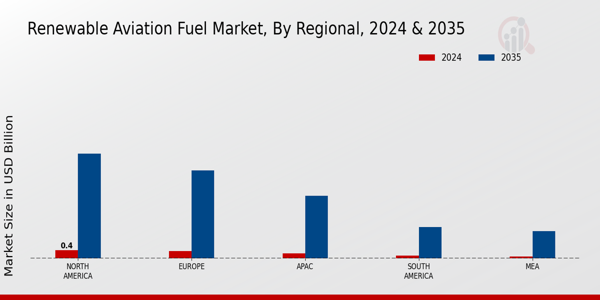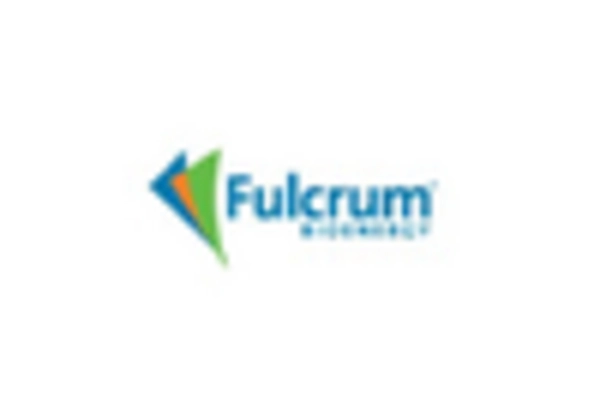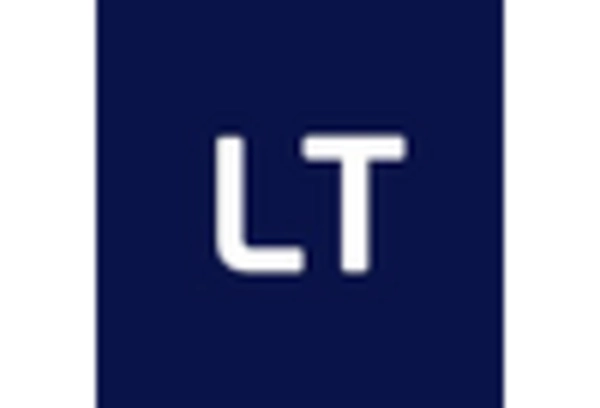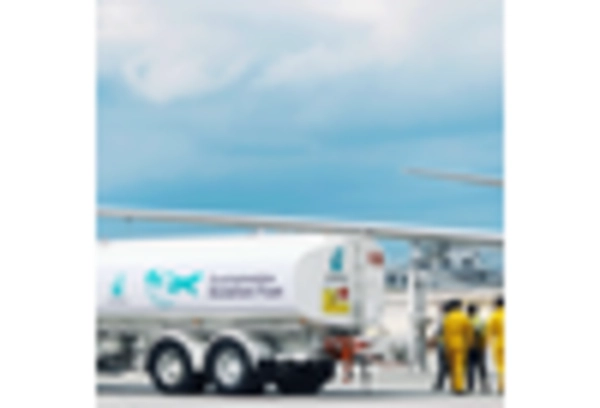Technological Innovations
Technological advancements play a crucial role in shaping the Renewable Aviation Fuel Market. Innovations in feedstock conversion processes and fuel production techniques are enhancing the efficiency and cost-effectiveness of renewable fuels. For instance, the development of advanced biofuels derived from non-food biomass is gaining traction, as it offers a sustainable alternative to conventional jet fuels. Recent studies indicate that the production of sustainable aviation fuel could reach 3 billion gallons by 2030, reflecting a significant increase in market potential. Furthermore, ongoing research into synthetic fuels and hydrogen-based solutions suggests that the Renewable Aviation Fuel Market may witness transformative changes in the coming years. These technological breakthroughs not only improve fuel performance but also contribute to the overall viability of renewable aviation fuels, making them an attractive option for airlines aiming to reduce emissions and comply with stringent regulations.
Collaborative Partnerships
Collaborative initiatives among stakeholders are emerging as a vital driver for the Renewable Aviation Fuel Market. Partnerships between airlines, fuel producers, and research institutions are facilitating the development and commercialization of sustainable aviation fuels. These collaborations often focus on sharing knowledge, resources, and technology to accelerate the transition to renewable fuels. For instance, several airlines have entered into agreements with biofuel producers to secure a stable supply of sustainable fuels, thereby reducing their reliance on fossil fuels. Such partnerships are essential for overcoming the challenges associated with scaling up production and distribution of renewable aviation fuels. As the Renewable Aviation Fuel Market continues to evolve, these collaborative efforts are likely to play a pivotal role in driving innovation and ensuring the successful integration of renewable fuels into the aviation sector.
Market Demand from Airlines
The Renewable Aviation Fuel Market is witnessing a robust increase in demand from airlines seeking to enhance their sustainability profiles. As public awareness of climate issues grows, airlines are increasingly prioritizing the adoption of renewable fuels to meet consumer expectations and regulatory requirements. Recent data suggests that airlines are projected to consume over 35 billion gallons of jet fuel annually by 2030, with a significant portion expected to come from renewable sources. This shift is not only driven by environmental considerations but also by the potential for cost savings in the long term. Airlines that invest in renewable aviation fuels may benefit from reduced fuel costs and improved operational efficiency. Consequently, the Renewable Aviation Fuel Market is poised for growth as airlines recognize the strategic advantages of transitioning to sustainable fuel options.
Increasing Environmental Concerns
The Renewable Aviation Fuel Market is experiencing a surge in demand driven by heightened environmental awareness among consumers and stakeholders. As climate change becomes an increasingly pressing issue, airlines are under pressure to reduce their carbon footprints. This has led to a growing interest in sustainable aviation fuels, which can significantly lower greenhouse gas emissions compared to traditional fossil fuels. According to recent data, the aviation sector accounts for approximately 2-3 percent of global carbon emissions, prompting regulatory bodies to advocate for cleaner alternatives. The Renewable Aviation Fuel Market is thus positioned to benefit from this shift, as airlines seek to meet sustainability targets and enhance their public image. The transition to renewable fuels not only addresses environmental concerns but also aligns with broader corporate social responsibility goals, making it a pivotal driver in the market.
Regulatory Frameworks and Incentives
The Renewable Aviation Fuel Market is significantly influenced by supportive regulatory frameworks and incentives established by governments worldwide. Policies aimed at reducing carbon emissions and promoting sustainable energy sources are creating a favorable environment for the adoption of renewable aviation fuels. For example, mandates for blending renewable fuels with conventional jet fuel are being implemented in various regions, encouraging airlines to invest in cleaner alternatives. Additionally, financial incentives such as tax credits and grants for research and development are further stimulating growth in the market. As regulatory bodies continue to tighten emissions standards, the Renewable Aviation Fuel Market is likely to expand, driven by the need for compliance and the pursuit of sustainability goals. This regulatory landscape not only fosters innovation but also enhances the competitiveness of renewable fuels in the aviation sector.


















Leave a Comment